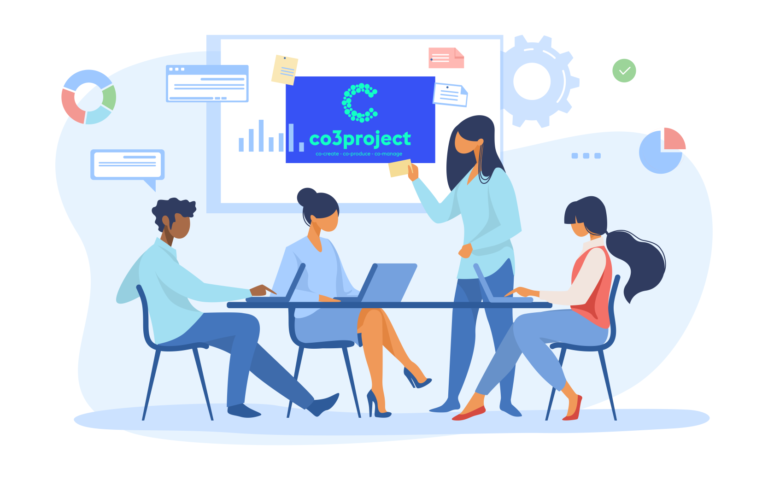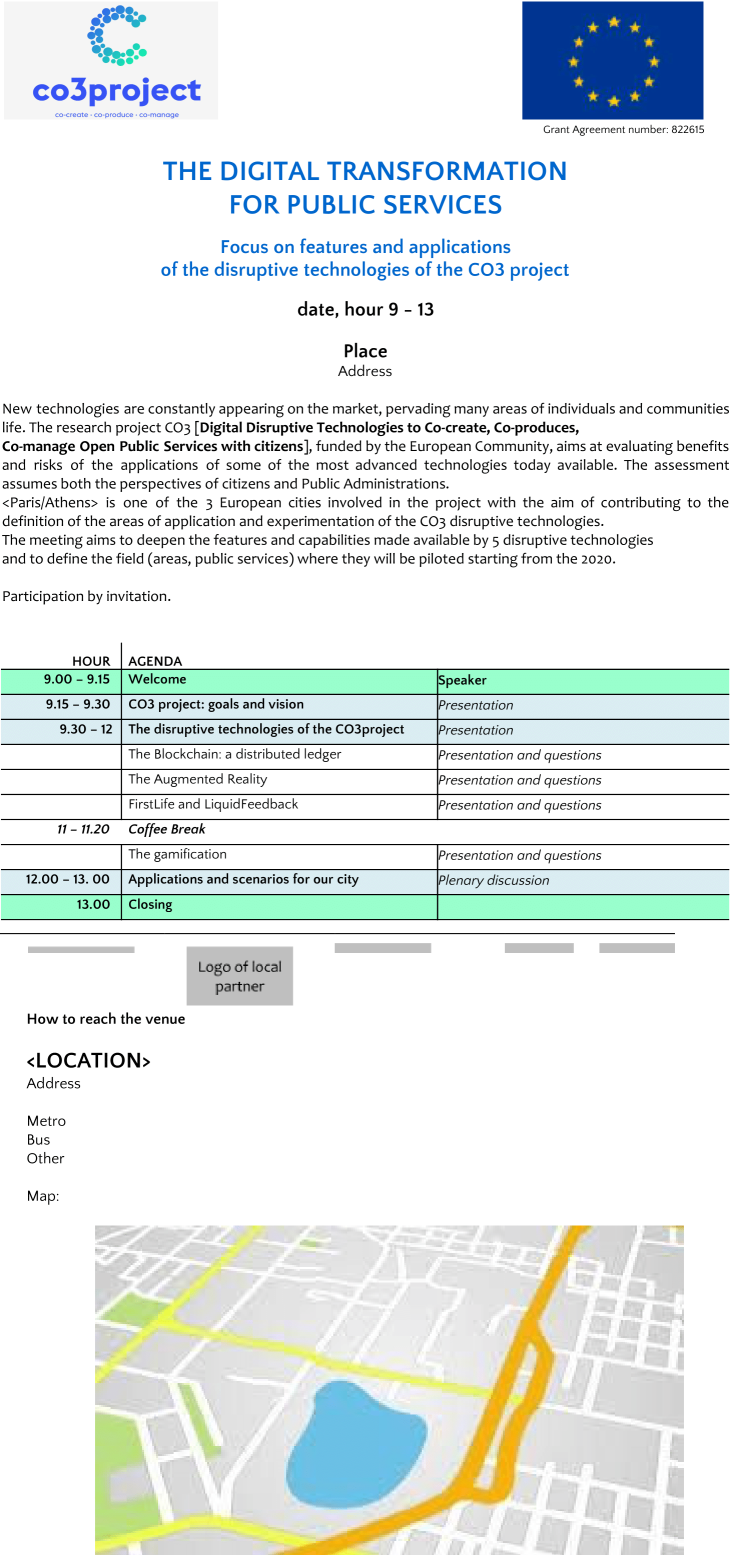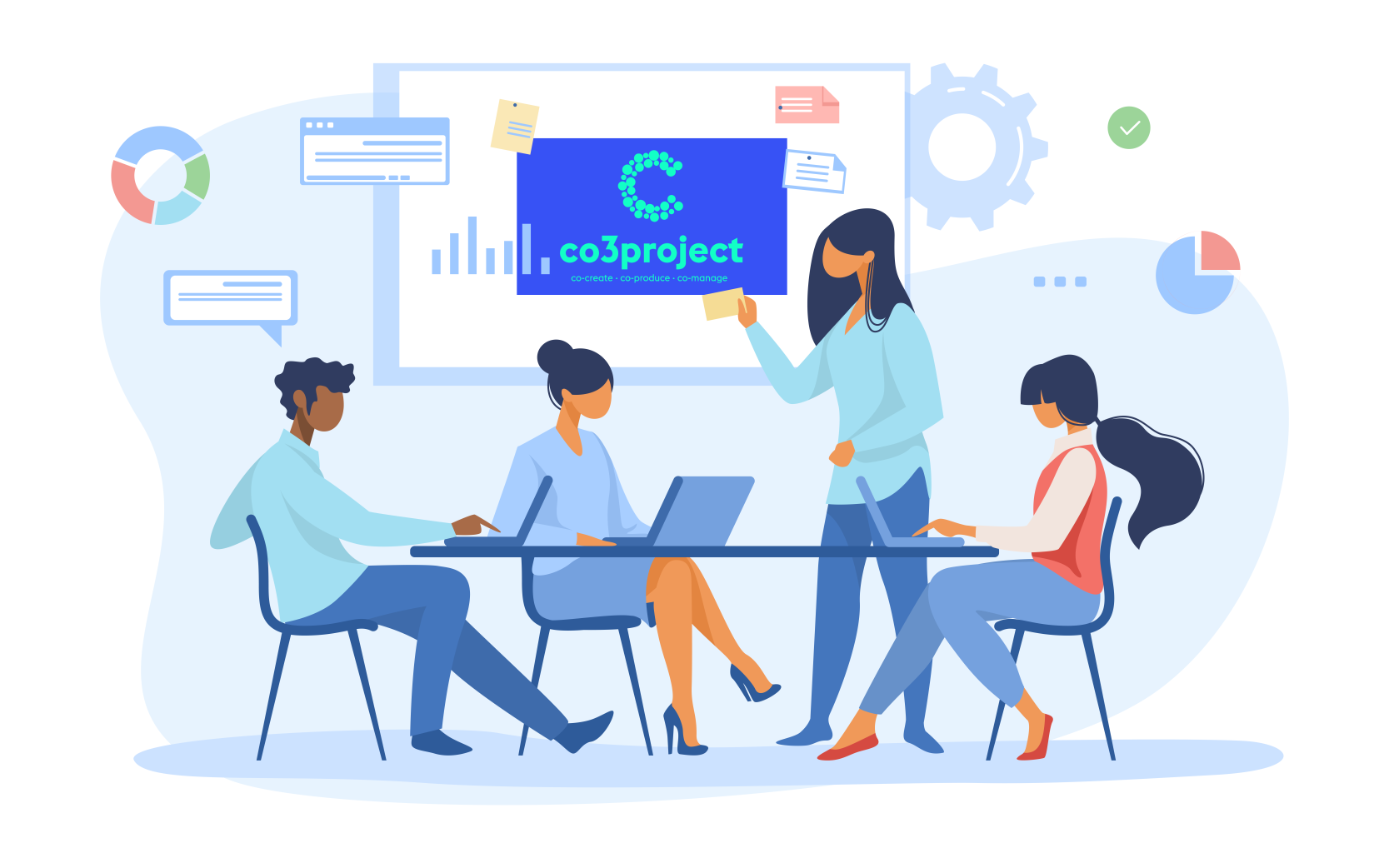The meetings joining CO3 technology partners, direct and indirect stakeholders, both held in group or as face to face interviews, will provide insights to outline the CO3 service scenarios and use case on the base of a common understanding of the capabilities offered by technologies and needs and opportunities offered by the pilots.
The aim of these discussions is to explore the end-users point of view on how the disruptive technology focused by CO3 will be able to enable future public services towards the co-creation, co-production and co-management.
These meetings aim also at:
- Start the conversation and engage in the loop the stakeholders
- Collect data and situated knowledge of the field of application of the CO3 technologies
The discussions will revolve around three main topics:
- The description of the specific technologies identified by CO3, focusing on their capabilities, opportunities and constraints (no technicalities) which will serve as an introduction to the discussion
- Starting from the area of interest identified by each pilot, the description of existing services, places, target audiences that currently characterize the public service. Moreover, the elicitation of needs is fundamental to hook the CO3 service scenarios to real conditions.
- The expected or envisaged services or models of interaction mediated by the CO3 technologies
Why are these meetings useful?
- Stimulate the dialogue to generate rich information, insights and knowledge/experiences sharing under the stakeholder’s perspective. In a group interview, this aspect is enhanced by the exchange among different people that can discuss and negotiate more than in an individual interview.
- Provide information directly from individuals who are invested in the issue or hold expert knowledge about a topic of which little is known among researchers.
- Provide information from people who can provide insights about actual conditions and situations.
- Provide a representation of diverse opinions and ideas.
- If conducted in groups, they provide a relatively low cost and efficient way to generate a great deal of qualitative information.
Limitations and pitfalls
- Even though they can be semi-structured, the interviews provide qualitative information, not adapt for drawing inferences about larger populations but about specific situations.
- If conducted in groups, although group interaction is generally seen as an advantage, there is always the possibility that the group setting may inhibit interaction – especially for/by certain individuals.

The procedure
TARGET
Individual or group discussions will involve the CO3 stakeholders, such as Public Administrations (policymakers, officers and public servants, technicians…) Associations, NGO and communities of citizens, including also private players. General inclusion criteria:
- 18 years or older
- Consent to participate in the study
- Experience with public services and active citizenship
RECRUITMENT PROCEDURE
Please make sure to recruit participants according to the service scenarios you are exploring. Select the communication channel most suitable for the specific target to be addressed. The communication to all potential participants shall include:
- Information about the project
- Request to participate
- Suggested dates and times
- Contact information

After the first contact, follow-up the invited participants to ensure they understood the procedures and will attend at the stated times.
NUMBER AND SCOPE OF MEETINGS
Each city pilot (Athens, Turin, Plaine Commune) is invited to conduct at least 2 group discussions to engage the stakeholders into the project conversations, introduce technologies, and know more about the field of application.
Each pilot will identify the persons to be invited, according to the expertise and role in the public service area of interest.
- Individual interviews are especially useful to engage policymakers, enrolling them into the project vision and get long-term visions on service scenarios and expected impacts.
- Groups interviews/meetings allow maximizing the possibility to collect the knowledge and get to a shared view of the project vision from a higher number of people and perspectives at the time. Deciding to conduct group sessions, at this stage, the suggestion is to create homogeneous groups, collecting people from the same organization or department. The group size is one of the critical factors to the success of the discussion. The minimum number suggested is 6 people; over 12-15 people the discussion risks to be not very inclusive. There is no requirement for single-gender groups, single organisation groups, and an equal number of male and females in each group is not required either. The focus groups should be composed on the basis of the relevance for the service scenarios to be focused. It is important that each member of the same group has experienced at least the same type of services to facilitate the group discussion.
Interviewer/Moderator
It is recommended that the interviewer/moderator of the discussion is part of the consortium team so that they are familiar with the relevant concepts.
Roles and responsibilities:
- Keep the interviewee/s focused, engaged, attentive and interested.
- Monitor time and use a limited time effectively.
- Use prompts and probes to stimulate discussion.
- Limit side conversations/topics
- Be prepared to explain or restate questions.
- Diffuse and pre-empt arguments
The interviewer shall always be accompanied by a second person in charge of taking notes of the meeting.
Venue
Both for hosting a group discussion/focus group or an individual interview, take care to have an n adequate room. It should be warm and friendly but not distract or disturbed by others. In the case of a group discussion, the seating should be arranged comfortably so that everyone can see everyone else without having to turn around. Please provide some refreshments for the participants.
Conducting the meetings
In the following, we have outlined the core phases to facilitate a focused discussion able to explore, probe, and ask questions on the CO3 future service scenarios enabled by the selected disruptive technology. They have been adapted to fit both with groups and individual meetings.
Introduction
During the introduction, the interviewer will generally.
- Introduce himself and the person that will record the session.
- Give a summary of the goal and topics of the meeting. The purpose of the meeting should be stated clearly and simply to the interviewees who should be allowed to ask questions.
- Describe the process/sequence and let the participants know about the time scheduled.
- If any, alert participants of recording devices. Assure the participants that everything they say will be treated confidently, and when findings are presented, any comments cannot be allocated to them. It should also be stressed that there are no right and no wrong answers that all comments are welcome and will remain confidential. Ensure them that their identities will not be revealed in any publications/reports (verbal consent).
Warm-up
The warm-up section usually involves
- The introduction of the participant/s, even though they are a colleague or acquaintances.
- Initiate the meeting, providing an overall description of the project, context and goals. This will allow the interviewed/s to focus on the topics of interest (existing services, technologies, innovation needs, …). Stimulate questions. This phase helps to set the stage to recall relevant experiences in related or similar fields.
Key content sections
The discussion becomes more specific and moves into obtaining participant/s’ opinion and feedback on the topics of interest. Encourage the participants to speak while using open questions and listen attentively. The language should reflect that of the participants.
Prepare the script of the interview, both for individuals and groups. The script includes:
- the objective and the information on the interview to be given
- the topics to be discussed
- questions (to be used to introduce topics, analyse specific aspects)
- data and visual stimuli are useful to focus the attention on the topic
- Respect the pace of the discussion given by the persons: the interview has to focus the identified topics; if the person/group introduces an argument that is at the end of the topic list of the interviewer, do not interrupt and follow their path. The order of the topics is not fixed, only the focused matters.
- Allow short breaks and pauses whenever they are needed.
Closure Phase (Summary and Closing)
It is essential to end every discussion properly with a closure phase. You should
- Summarize important statements and ensure that there are no misunderstandings.
- Offer the possibility to add statements on the topic and additional information that may have been omitted or forgotten.
- Thank the participant/s for their participation and effort. Give some additional explanation regarding what will happen with the results.
- Do not turn off the tape recorder – keep the tape going. Close the discussion and let people leave. The last few minutes are always important. Sometimes the comments made after the focus group discussion situation are the most valuable ones the participants have made all day.
Example of questions
- Considering the context/service, which information is not explicitly provided or easy to access?
- Is there any tacit knowledge that can be conveyed to people?
- Which information available but little used could be enhanced through CO3?
- Thinking to the services you are providing/using, which ones would be decentralized to reach a wider audience?
- Are there any self-organized processes that could profitably be enhanced (in participation or efficacy or efficiency…) by digital technology?
- What interactions could be facilitated?
- Among citizens, with associations, with PA? Other actors?
- Which places you imagine would especially adapt to host a pilot of co-creation and co-management of public services?
- Imagining to be able to acknowledge and incentivize people engagement and participation in public services, which types of rewards would be given? (excluded monetary reward)
- Tangible (objects)
- Intangible (e.g. reputation level or points, virtual objects), access to other services, …
- Are there decision-making processes that could benefit from information and input coming from citizens?
- Are there any decision-making processes that could be made more inclusive and provide for a participation summit for the final recipients?
Data collection
Keep track of the held meetings, specifying a few data in a sheet with time, location and invited individuals. the required data are:
- City: Athens, Paris, Turin
- Type of meeting: T: Technology Focus; P: Pilot Visit; I: Face to Face Interview; C: Internal meeting (within consortium partners); D: Co-Design Workshop; other/personalize
- Number of people involved
If possible, provide a concise indication of the goal of the meeting. The tracking of the participants is also important, store the information of the involved organizations and participants have to be gathered on a minimum level to monitor the range of profiles included in this phase and to be able to describe them. At this stage, a participant’s signature sheet is enough to map the sample.

It is needed to identify and intrust a person who takes notes of the most important key points of the discussion, records the information provided, relevant references and closely observes the situation (e.g. individuals’ reactions and when in groups: negotiation dynamics, group responses). This is mandatory in case the session is not audio/video-recorded. Additionally, these notes serve as a “back-up” in case something happens with the recording equipment.
- Audio/Video Recording
If you are going to record the session, check its working before the meeting. Make sure that you are familiar with it. The recording should not be emphasised. Become familiar and confident in using the recorder. Avoid checking it during the discussion. The records should be used to transcribe the discussion verbatim. It is also possible to videotape the discussion if participant/s give their consent.
Learn from data collected
The minutes and data collected after each meeting/interview should be transcripted (if recorded) and completed with the moderator’s notes (considering also the recorder’s notes). In this phase it is important to highlight the priorities, needs, constraints, expectations, pragmatic hints. Common items, phrases or themes should be highlighted together with any relevant comments.
Closing words
Following the guide enabled us to gather the feedback that we needed to documentate the scenarios and develop the technical requiremenets for conducting the pilots.


